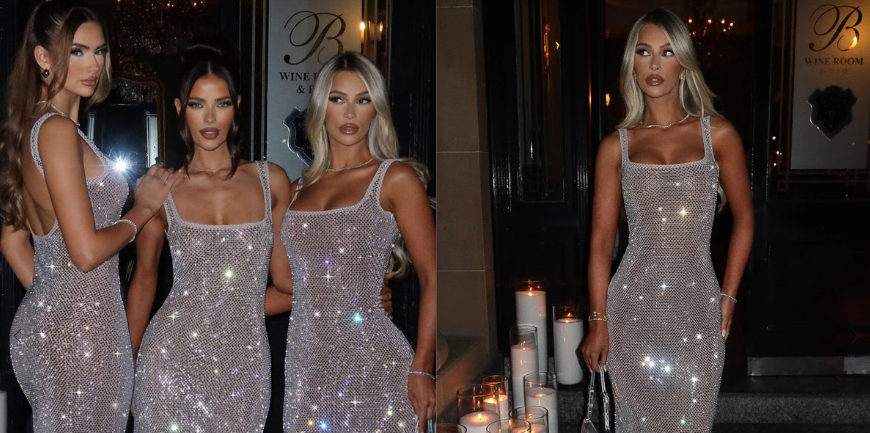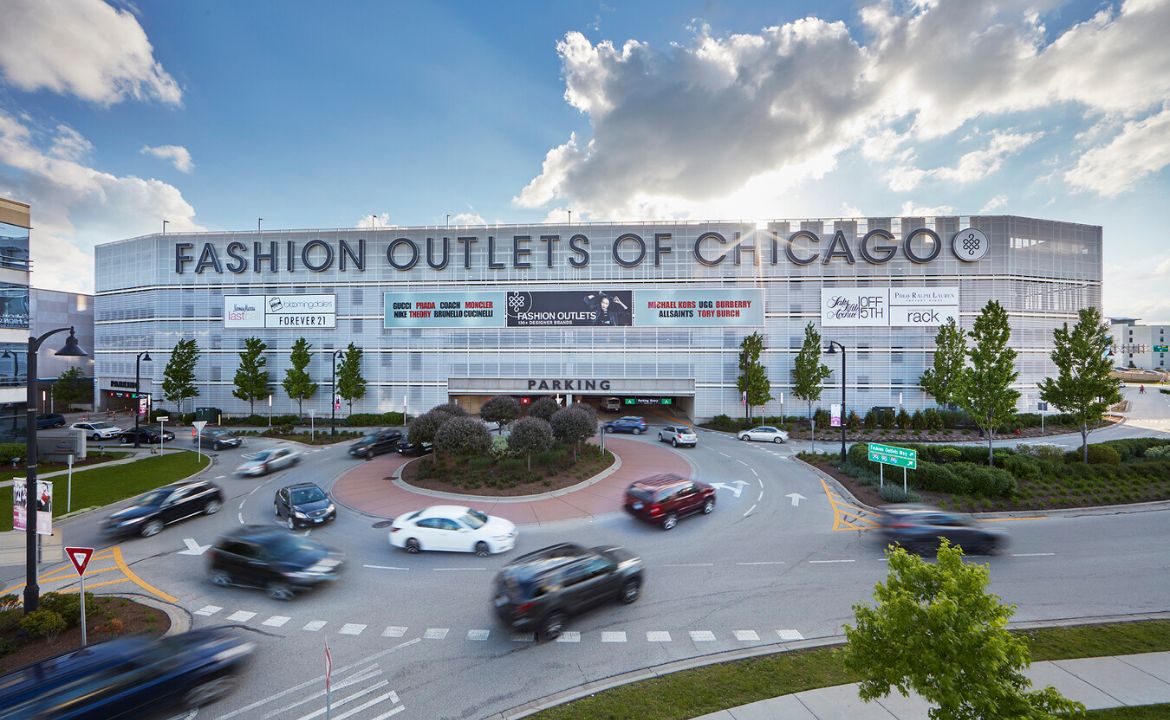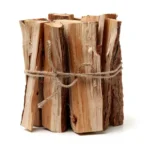Now Reading: A Guide to 1940s Fashion: Style in an Era of Change
-
01
A Guide to 1940s Fashion: Style in an Era of Change
A Guide to 1940s Fashion: Style in an Era of Change
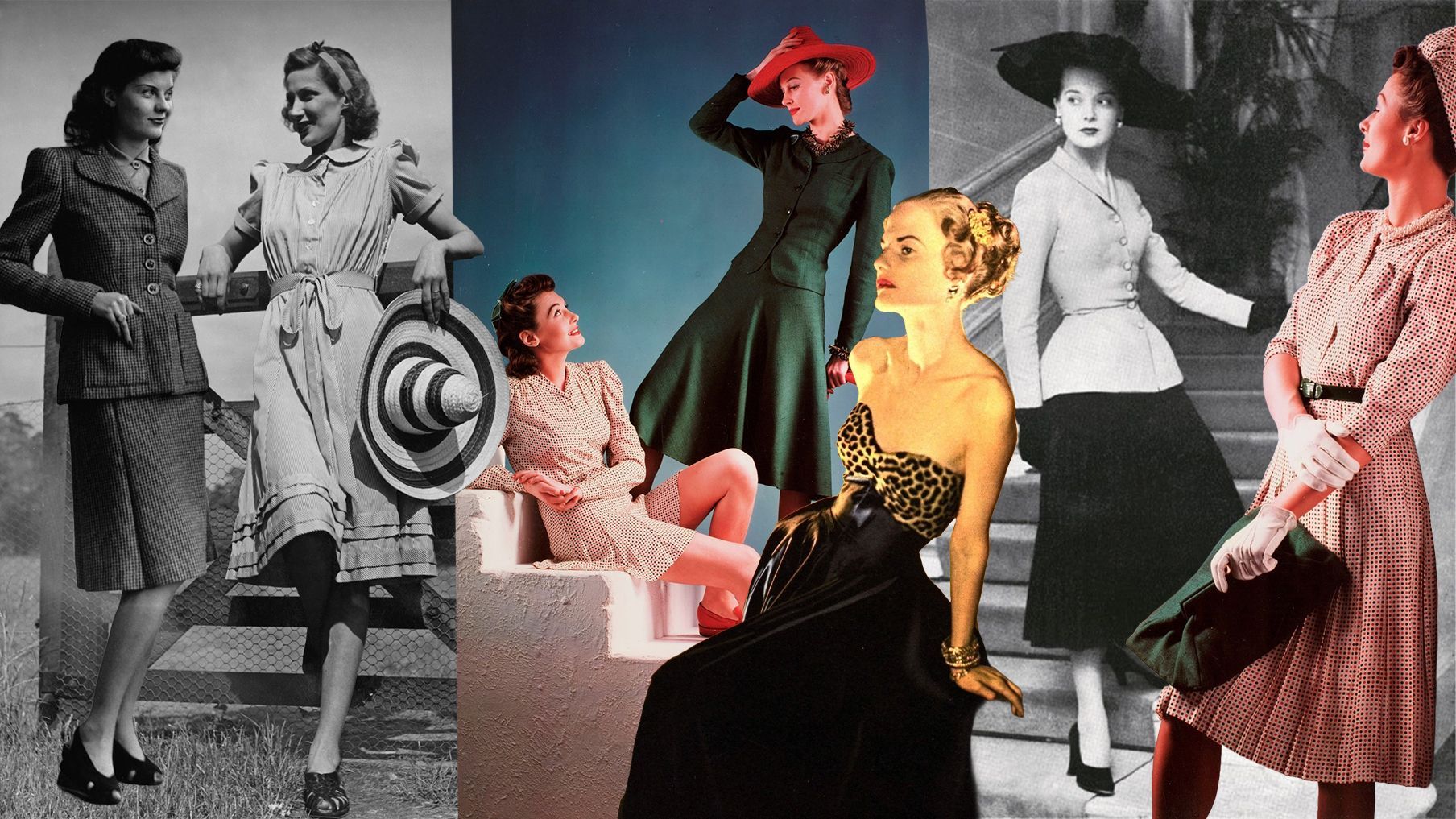
The 1940s was a decade of profound transformation, and its fashion tells a compelling story of resilience, innovation, and glamour. Shaped by the realities of World War II and the optimism of its aftermath, 1940s fashion evolved from practical, ration-driven styles to the more extravagant silhouettes that heralded a new era of prosperity.
This period’s clothing balanced utility with understated elegance, creating iconic looks that continue to inspire designers and style enthusiasts today. From sharp-shouldered suits to flowing victory dresses, the styles of this decade were a direct reflection of the social and economic climate. Understanding 1940s fashion is like opening a time capsule into a period where every stitch and seam had a purpose.
Key Takeaways
- World War II heavily influenced early 1940s fashion, leading to practical, utilitarian styles due to fabric rationing and women’s new roles in the workforce.
- Key elements of wartime fashion included tailored suits, A-line skirts ending at the knee, and a focus on a strong shoulder silhouette.
- After the war, Christian Dior’s “New Look” revolutionized fashion with its emphasis on femininity, featuring full skirts, cinched waists, and soft shoulders.
- Accessories were crucial for adding personal flair, with hats, gloves, and statement jewelry playing a significant role in completing an outfit.
- The legacy of 1940s fashion endures, with many of its iconic trends and silhouettes reappearing in contemporary collections.
The Impact of World War II on Fashion
The early part of the decade was completely dominated by World War II. Governments in both the United States and Europe imposed strict rationing on materials like wool, silk, nylon, and leather to support the war effort. This had a direct and immediate impact on 1940s fashion. Designers had to become incredibly creative with limited resources. The “Utility Clothing Scheme” in Britain, for example, dictated everything from the number of pleats in a skirt to the absence of cuffs on trousers.
The result was a more streamlined and practical silhouette. Clothing became less of a frivolous pursuit and more of a symbol of patriotic duty and resourcefulness. Women on the home front, taking on jobs previously held by men, needed durable and functional attire, further pushing the trend toward simple, well-made garments.
Women’s Wartime Utility Styles
As women entered factories and farms, their wardrobes adapted. The defining look for women during the war years was the tailored suit. This wasn’t the power suit of later decades but a practical ensemble featuring a boxy jacket with padded shoulders and an A-line skirt that fell just to the knee. This silhouette conserved fabric while allowing for ease of movement. Trousers, once considered improper for women, became widely accepted out of necessity. Styles like high-waisted slacks and “siren suits”—practical all-in-one jumpsuits—were common.
The focus was on durability and comfort. The resourceful nature of the era also popularized the idea of “make do and mend,” where women would alter, repair, and repurpose old clothing to create something new, showcasing incredible ingenuity in the face of scarcity.
The Rise of the A-Line Skirt
The A-line skirt was a cornerstone of 1940s fashion. Its shape, narrow at the hips and gradually flaring out to the hem, was both stylish and economical with fabric. Unlike the fuller skirts of the previous decade, the 1940s A-line skirt was typically knee-length, a practical choice that saved material and made it easier for women to ride bicycles and work in active roles.
These skirts were often made from durable fabrics like wool, rayon, or cotton and featured simple designs, sometimes with a few pleats or gores to add a bit of fullness without being wasteful. Paired with a simple blouse or a knitted top, the A-line skirt created a classic and versatile look that defined the wartime silhouette.
The Importance of the Blouse
Blouses were an essential wardrobe staple that allowed women to add variety and femininity to their otherwise practical outfits. They were often the one piece where a little more detail was permitted. Popular styles featured small, rounded “Peter Pan” collars, puffed sleeves, and delicate button-fronts. Rayon was a common material, as it mimicked the feel of silk but was more affordable and available.
A pretty blouse could soften the masculine lines of a tailored suit or be tucked into a pair of high-waisted trousers for a more casual, yet put-together, look. Many women owned several blouses to mix and match with their skirts and suits, making them a key component of the resourceful 1940s fashion landscape.
Post-War Splendor: The “New Look”
In 1947, the fashion world was turned on its head by Parisian designer Christian Dior. His debut collection, dubbed the “New Look” by American journalists, was a radical departure from the austere styles of the war. It was a celebration of femininity and extravagance. The “New Look” featured rounded, soft shoulders, a tightly cinched waist, and a very full, long skirt that used yards of luxurious fabric.
This opulent silhouette was a direct rebellion against wartime restrictions and symbolized a return to glamour and prosperity. While initially controversial for its lavish use of material so soon after years of rationing, the “New Look” quickly became the dominant style of the late 1940s and set the tone for the decade to come.
Menswear in the 1940s
Men’s 1940s fashion also saw a divide between the war and post-war years. During the war, military uniforms were the most common sight. For civilians, the “Victory Suit” emerged, a pared-down version of the traditional suit with no vest, no pocket flaps, and narrower lapels to conserve wool. Trousers were cuffless and streamlined. After the war, menswear became bolder.
The double-breasted suit made a strong comeback, and hand-painted silk ties featuring bold, colorful designs became a popular way for men to express their individuality. The overall silhouette became fuller and more relaxed, reflecting the newfound sense of optimism and freedom. Casual wear also grew in popularity, with polo shirts and Hawaiian shirts gaining traction for leisure activities.
The Essential Role of Accessories
With clothing styles being relatively simple due to rationing, accessories became the primary way to showcase personal style. They were the key to elevating a basic utility dress or suit into a fashionable statement.
Hats, Gloves, and Handbags
No outfit was complete without a hat. Styles ranged from small, tilted fascinators and berets to wider-brimmed hats in the later years. Gloves were also a mandatory accessory for any well-dressed woman, typically wrist-length and worn for all daytime occasions. Handbags were often large and practical during the war, but smaller, more structured clutch bags became popular with the “New Look.”
The Power of Jewelry
Jewelry provided a splash of glamour. Because precious metals were scarce, designers turned to creative alternatives. Costume jewelry made from plastics like Bakelite, wood, and non-precious metals became highly fashionable. Brooches, often in patriotic or whimsical shapes, were particularly popular and could be pinned to a lapel or a hat to add a personal touch.
1940s Hairstyles and Makeup
The beauty trends of the 1940s were just as iconic as the clothing. Women’s hairstyles were elaborate and carefully coiffed. Victory rolls, intricate updos, and soft waves were incredibly popular. These styles kept hair neatly away from the face, which was practical for work but also very glamorous. Headscarves and snoods were also widely used to protect hair in the factory and add a pop of color. Makeup was defined by a strong, bold red lip. A clear complexion, defined eyebrows, and a touch of mascara completed the look. Even during wartime, lipstick was seen as a morale booster and was one of the few cosmetics not in short supply.
The Influence of Hollywood Glamour
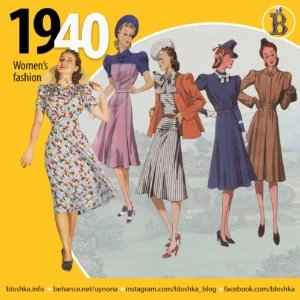
Hollywood stars were the ultimate trendsetters of 1940s fashion. Actresses like Lauren Bacall, Ingrid Bergman, and Rita Hayworth captivated audiences with their on-screen style. Lauren Bacall’s chic, tailored suits embodied sophisticated glamour, while Rita Hayworth’s femme fatale look in films like Gilda showcased the slinky, elegant eveningwear of the era. On-screen fashion was often more lavish than what the average person could afford, but it provided inspiration and a sense of escapism. Women would try to emulate the hairstyles and makeup of their favorite stars, bringing a touch of Hollywood magic into their everyday lives. These silver screen icons defined what it meant to be glamorous and had a lasting impact on popular style.
Children’s Fashion in the 1940s
Children’s clothing during the 1940s mirrored the practical trends of adult fashion. Because children grew so quickly, their clothes were designed to be durable and adaptable. The “make do and mend” philosophy was especially important for children’s wardrobes, with hand-me-downs being the norm. Girls often wore simple cotton dresses, pinafores, and skirts, often with puffed sleeves and Peter Pan collars. For boys, shorts, button-down shirts, and knitted sweaters were standard attire. As with adults, clothing became a bit more detailed and varied after the war, but the emphasis remained on practical, hard-wearing fabrics that could withstand active play.
|
Feature |
Early 1940s (Wartime) |
Late 1940s (Post-War) |
|---|---|---|
|
Overall Silhouette |
Boxy, sharp shoulders, straight lines |
Soft shoulders, cinched waist, full skirt |
|
Skirt Length |
Knee-length (A-line) |
Mid-calf to ankle-length (full circle) |
|
Key Materials |
Rayon, wool blends, cotton, limited use of silk |
Abundant silk, nylon, wool, luxurious fabrics |
|
Defining Look |
The Tailored Utility Suit |
Dior’s “New Look” |
|
Men’s Style |
The “Victory Suit,” single-breasted, no cuffs |
Double-breasted suits, pleated trousers, bold ties |
|
Mood |
Practical, resourceful, patriotic |
Optimistic, glamorous, extravagant |
The Enduring Legacy of 1940s Fashion
The influence of 1940s fashion is still felt today. The strong shoulder silhouette, so prominent in wartime suits, has been reinterpreted by designers countless times over the decades. The high-waisted, wide-leg trousers that became acceptable for women in the 1940s are now a modern wardrobe staple. Even Dior’s “New Look” continues to inspire, with its celebration of the hourglass figure appearing in formalwear and wedding dress designs. As noted in trend reports on sites like Forbes Planet, classic styles often see a resurgence.
The era’s focus on well-made, tailored pieces that were built to last offers a sustainable alternative to today’s fast fashion. The blend of practicality and glamour that defined 1940s fashion ensures its timeless appeal.
Conclusion
The 1940s was a decade of two distinct halves, and its fashion perfectly captures this duality. It moved from the resourceful and restrictive utility styles of the war to the joyful extravagance of the post-war “New Look.” It was an era that embraced practicality without sacrificing style, championing strong silhouettes, feminine details, and the art of accessorizing.
More than just clothing, 1940s fashion tells a story of a world undergoing immense change, reflecting the resilience, creativity, and enduring spirit of the people who lived through it. Its legacy is not just in the specific garments but in the attitude of making the most of what you have and celebrating the return of beauty and optimism.
Frequently Asked Questions (FAQ)
Q1: What are the key characteristics of 1940s fashion?
The key characteristics of early 1940s fashion include knee-length A-line skirts, tailored suits with padded shoulders, practical trousers for women, and a “make do and mend” philosophy. In the late 1940s, the “New Look” introduced cinched waists, full, long skirts, and a more overtly feminine silhouette.
Q2: How did World War II affect fashion in the 1940s?
WWII led to severe fabric rationing, which resulted in simpler, more practical clothing designs. Utilitarian styles became the norm, with a focus on durability and conserving materials. It also normalized women wearing trousers as they took on new roles in the workforce.
Q3: Who were the major fashion icons of the 1940s?
Hollywood stars were the biggest fashion icons. Actresses like Lauren Bacall, Ingrid Bergman, Katharine Hepburn, and Rita Hayworth influenced trends with their on-screen and off-screen style, from tailored suits to glamorous evening gowns.
Q4: What was Christian Dior’s “New Look”?
The “New Look” was Christian Dior’s revolutionary 1947 collection that rejected wartime austerity. It featured soft, rounded shoulders, a tiny waist, and a very full, mid-calf length skirt. It was a celebration of opulence and femininity and defined the post-war fashion landscape.
Q5: Are 1940s fashion trends still popular today?
Yes, many 1940s fashion trends continue to be popular. Elements like high-waisted trousers, A-line skirts, puffed sleeves, and the strong shoulder silhouette are frequently seen on modern runways and in street style, proving the timeless appeal of the era’s designs.


